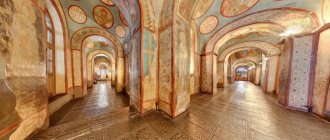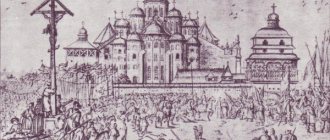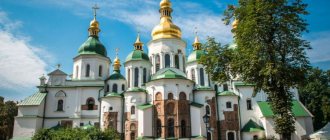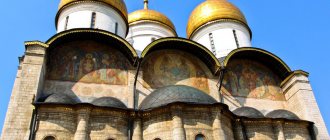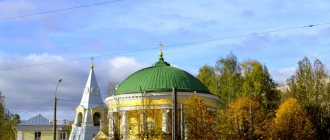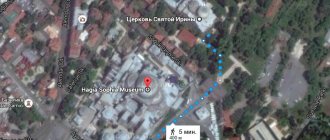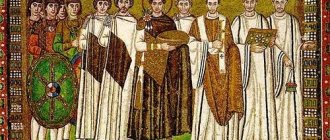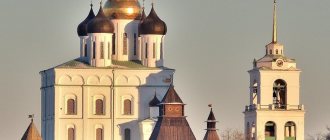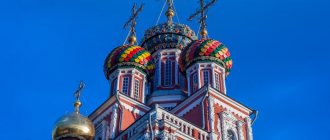The Church of Hagia Sophia was built under Emperor Justinian. He was one of the most famous rulers of Byzantium, coming to power in 527. His name is associated with many actions that led to the power of the Byzantine Empire - the creation of a code of laws, the expansion of territory, the construction of palaces and temples. But the most famous temple in Constantinople is perhaps the Hagia Sophia.
Hagia Sophia in Constantinople, the Cathedral Church of Hagia Sophia, Hagia Sophia, the Great Church - this interesting building has many names. At one time, there were many legends surrounding the erected temple about the resources expended, but they all paled in comparison with reality.
Construction of the cathedral
The idea alone exceeded all possible goals - the temple of Hagia Sophia in Constantinople was supposed to be better than the famous temple of King Solomon in Jerusalem. For five years (532-537), ten thousand workers worked to build a new symbol of Constantinople. The temple was made of brick, but much more expensive material was used for decoration. Ornamental stone, gold, silver, pearls, precious stones, and ivory were used here. Such investments greatly tightened the treasury of the empire. Eight columns were brought here from the famous Temple of Artemis in Ephesus. The whole country worked to build this miracle.
By the time the construction of the Hagia Sophia temple in Istanbul began, Byzantine craftsmen already had experience in constructing similar structures. Thus, the architects Anthimius of Thrall and Isidore of Miletus completed the construction of the Church of Sergius and Bacchus in 527. It was they who were destined by fate to become the builders of a great legend, a symbol of the greatness and power of the empire.
Ottoman conquerors
On May 29, 1453, the temple was captured by the Turks and its precious decorations were plundered. The worshipers were killed. Sultan Mahmed II, entering the cathedral, was blinded by its splendor, so he ordered the establishment of a mosque here. Soon 4 minarets were added to the cathedral, calling the mosque Hagia Sophia.
In 1847, by order of Sultan Abdul I, restoration was carried out in the mosque. On the columns of the building were placed 8-meter wooden shields, covered with leather, with the names of Allah and the Prophet Mohammed written on them.
Interior of the cathedral
The interior decoration is particularly luxurious. The cathedral amazes with its unprecedented splendor and royal luxury. The ceiling is made of gold, from which gold lamps are suspended, the floor is made of pure gold, covered with mosaics, 8 green jasper columns from the Temple of Artemis in Ephesus, a golden cross in the altar, decorated with pearls, the luxury of decorating the interior with colored marble and the splendor of the ceremonies that took place in the temple.
Everything emphasizes the grandeur, majesty, pomp and solemnity of Hagia Sophia. The luxurious decoration of the sanctuary inspired the crowd of thousands of people with the idea of the powerful Byzantine Empire and the Church.
The main decoration of the cathedral is the altar barrier with the image of Christ , the archangels, St. Mary, the apostles and prophets, made in the form of embossed silver. The altar of the cathedral is made of gold and copper, iron and glass, yakhont, emerald and beads, onyx and diamonds. Church utensils for worship are made of silver.
Mosaic for wall cladding
The walls of the temple are covered with mosaics with the following compositions:
- Throne image of the Virgin Mary holding the Child Christ on her lap. On either side of the Mother of God are two archangels. Mary’s beautiful face, full of femininity, the soft oval of her face, her regular nose, and her scarlet lips speak of the earthly character of the Mother of God and, at the same time, captivate with her spirituality.
- Half-figures of the 12 apostles and the four holy patriarchs of Constantinople: Herman, Tarasius, Nikephoros, Methodius.
- 16 Old Testament prophets and 14 saints, whose clothes fall in calm folds, so that you want to touch their clothes to feel their warmth.
- Jesus Christ sitting on the throne with the Gospel revealed in the words: “Peace be with you! I am the light of the world! in the left hand and blessing with the right. On either side of him are half-figures of the Virgin Mary and Archangel Michael.
- Portrait of Emperor Alexander I , presented in a vestment decorated with precious stones and a crown with pendants. In the left hand of the emperor is an orb. The mosaic with silver cubes depicts the emperor behind the Easter image.
The mosaic is distinguished by its exquisite beauty and the greatest craftsmanship. The figures are executed with an excellent sense of proportion. The images are spiritual: large eyes, filled with sadness, directed into the unknown distance. In solemn calm - detachment from the earthly world.
The finest transitions of color without hard contours, soft colorful modeling give the faces an earthly, sensual character. Christian frescoes coexist with elements of Islamic decoration. On four large oval-shaped shields there are quotes from the Koran. There is also a carved marble minbar from where the imam read sermons. On both sides there are bronze candlesticks.
On the walls and columns there are more than 70 Slavic inscriptions made by people from Kievan Rus. Inscriptions were scratched on the marble parapets of the cathedral by soldiers of the Varangian Guard of the Byzantine Emperor in the Middle Ages.
floating dome
The building's plan has a rectangle with sides 79 meters by 72 meters. The height of the Church of Hagia Sophia along the dome is 55.6 meters, the diameter of the dome itself, “hanging” above the temple on four columns, is 31.5 meters.
Hagia Sophia in Istanbul was built on a hill, and its position stood out from the general background of the city. Such a decision amazed his contemporaries. Its dome stood out especially, visible from all sides of the city, and standing out in the dense buildings of Constantinople.
Architecture and interior decoration
The Hagia Sophia Mosque (Cathedral) in Turkey is a rectangular basilica of classical shape with three naves, the western part of which is adjacent to two vestibules. The length of the temple is 100 meters, the width is 69.5 meters, the height of the dome is 55.6 meters, and its diameter is 31 meters. The main material for the construction of the building was marble, but light bricks made of clay and sand were also used. In front of the facade of Hagia Sophia there is a courtyard, in the middle of which there is a fountain. And there are nine doors leading into the museum itself: in the old days, the central one could only be used by the emperor himself.
But no matter how majestic the church looks from the outside, the true masterpieces of architecture lie in its interior decoration. The basilica hall consists of two galleries (upper and lower), made of marble, specially imported to Istanbul from Rome. The lower tier is decorated with 104 columns, and the upper - 64. It is almost impossible to find an area in the cathedral that is not decorated. The interior features numerous frescoes, mosaics, silver and gold coverings, and terracotta and ivory elements. There is a legend that says that Justinian initially planned to decorate the temple entirely from gold, but soothsayers dissuaded him, predicting times of beggars and greedy emperors who would not leave a trace of such a luxurious structure.
The Byzantine mosaics and frescoes in the cathedral are of particular value. They were preserved quite well, largely due to the fact that the Ottomans who came to Constantinople simply plastered over the Christian images, thereby preventing their destruction. With the advent of Turkish conquerors in the capital, the interior of the temple was supplemented with a mihrab (a Muslim equivalent of an altar), the Sultan's box and a marble minbar (a pulpit in a mosque). Also, traditional Christian candles left the interior and were replaced by chandeliers made from lamps.
In the original design, Aya Sophia in Istanbul was illuminated by 214 windows, but over time, due to additional buildings in the shrine, only 181 of them remained. In total, the cathedral has 361 doors, one hundred of which are covered with various symbols. Rumor has it that every time they are counted, new doors that have never been seen before are found. Under the ground part of the structure, underground passages were discovered, flooded with groundwater. During one of the studies of such tunnels, scientists found a secret passage leading from the cathedral to another famous landmark of Istanbul - Topkapi Palace. Jewelry and human remains were also discovered here.
The decoration of the museum is so rich that it is almost impossible to briefly describe it, and not a single photo of the Hagia Sophia in Istanbul can convey the grace, atmosphere and energy that is inherent in this place. Therefore, be sure to visit this unique historical monument and see for yourself its greatness.
How to get there
Hagia Sophia is located in Sultanahmet Square, in the old city district of Istanbul called Fatih. The distance from Ataturk Airport to the attraction is 20 km. If you plan to visit the temple immediately upon arrival in the city, then you can get to the place by taxi or by public transport, represented by the metro and tram.
You can get to the metro directly from the airport building by following the appropriate signs. You need to take the M1 line to Zeytinburnu station. The fare will be 2.6 tl. Upon exiting the subway, you will have to walk a little more than a kilometer east along Seyit Nizam Street, where the T 1 Kabataş – Bağcılar tram stop is located (price per trip 1.95 tl). You need to get off at the Sultanahmet stop, and literally after 300 meters you will find yourself at the cathedral.
If you are going to the temple not from the airport, but from some other point in the city, then in this case you also need to get on the T1 tram line and get off at the Sultanahmet stop.
Note: In which area of Istanbul is it better for a tourist to stay for a few days?
Practical information
- Exact address: Sultanahmet Meydanı, Fatih, İstanbul, Türkiye.
- Cost of visiting: free.
- The prayer schedule can be viewed on the website: namazvakitleri.diyanet.gov.tr.
Useful tips
If you are planning to visit Hagia Sophia in Istanbul, be sure to pay attention to the recommendations of tourists who have already been here. We, in turn, having studied reviews from travelers, have compiled our top list of the most useful tips:
- It is best to go to the attraction by 08:00-08:30 in the morning. After 09:00, large queues form at the ticket office at the cathedral, and standing in the open air, especially at the height of the summer season, is quite exhausting.
- If, in addition to Hagia Sophia, you plan to visit other iconic places in Istanbul with paid entrance, then we advise you to purchase a special museum card, valid only within the metropolis. Its cost is 125 tl. This pass will allow you not only to save money, but also to avoid long lines at the ticket office.
- Before stepping on the carpet, you must remove your shoes.
- Avoid visiting the mosque during prayer times (5 times a day), especially at noon on Fridays.
- Women are allowed to enter Hagia Sophia only wearing headscarves. They can be taken for free upon entry.
- You can take photos of the interior of the building, but you should not take photos of worshipers.
- Be sure to bring water with you. During the summer months, Istanbul is quite hot, so you simply cannot do without liquid. You can also buy water on the territory of the cathedral, but it will cost several times more.
- Tourists who visit the museum recommend setting aside no more than two hours for a tour of Hagia Sophia.
- To ensure that your experience of visiting the cathedral is as complete as possible, we recommend hiring a guide. You can find a guide who speaks Russian right at the entrance. Each of them has its own price, but in Turkey you can always bargain.
- If you do not want to spend money on a guide, then purchase an audio guide, and if this option does not suit you, then before visiting the cathedral, watch a detailed film about Hagia Sophia from National Geographic.
- Some travelers do not recommend visiting the temple in the evening, because, according to them, only in daylight can you fully see all the details of the interior.
Inside the temple
In front of the entrance to the Hagia Sophia Cathedral there is a spacious courtyard with a fountain located in the center. There are nine doors leading into the temple itself; the right to enter through the central door was granted only to the emperor and the patriarch.
The inside of the Hagia Sophia in Istanbul looks no less beautiful than the outside. The huge domed hall, corresponding to the image of the universe, evokes deep thoughts in the visitor. There is no point in even describing all the beauty of the temple; it is better to see it once.
How to get there, work schedule
Hagia Sophia is located in the oldest district of Istanbul, where there are many historical places - the Blue Mosque, the Cistern, Topkapi. This is the most significant building in the city, and not only native Istanbul residents, but also any tourist will tell you how to get to the museum. You can get there by public transport on the T1 tram line (Sultanahmet stop).
The museum is open from 9:00 to 19:00, and from October 25 to April 14 – until 17:00. Monday is a day off. There is always a long line at the box office, so you need to arrive early, especially in the evening: ticket sales stop an hour before closing. You can buy an electronic ticket on the official website of Hagia Sophia. Entrance costs 40 liras.
Cathedral mosaics
In earlier times, the tops of the walls were covered with mosaics with paintings on various themes. During the time of iconoclasm in 726-843, they were destroyed, so the current situation does not fully reflect the picture of the former beauty of the interior decoration of the building. In later times, new artistic creations were created in the Church of Hagia Sophia in Byzantium.
Mosaic image of the Virgin Mary in the apse
Destruction of Hagia Sophia
The Church of St. Sophia was destroyed by fires and earthquakes, but each time it was restored. In 1204, the interior, plundered by the crusaders, could not be restored. The destruction of the Hagia Sophia and the end of greatness came with the fall of Constantinople in 1453 . Thousands of citizens were saved in the temple on the day of the death of Byzantium.
Restoration work in the temple began in 1935 by order of the President of Turkey. Now Hagia Sophia has acquired the status of a museum. From the Byzantine temple the entire city is visible at a glance.
Legends and interesting facts
There are also interesting legends associated with the Hagia Sophia in Turkey. So on one of the marble slabs of the temple you can see a handprint. According to legend, it was left by Sultan Mehmed II, who conquered Constantinople. When he rode into the temple on a horse, the horse got scared and reared up. To stay in the saddle, the conqueror had to lean against the wall.
Another story is connected with one of the niches of the temple. If you put your ear to it, you hear a noise. People say that during the assault, a priest took refuge in this niche, and the noise reaching us is his endlessly continuing prayer for salvation.
Byzantine style
St. Sophia Cathedral, photos of which currently adorn the advertising products of many travel agencies, is a classic embodiment of the imperial Byzantine style in architecture. This style is easily recognizable. With its monumental grandeur, it certainly goes back to the best traditions of imperial Rome and Greek antiquity, but it is simply impossible to confuse this architecture with something else.
Byzantine temples can easily be found at a considerable distance from historical Byzantium. This direction of temple architecture is still the predominant architectural style throughout the territory historically dominated by the Orthodox branch of world Christianity.
These structures are characterized by massive domed tops above the central part of the building and arched colonnades below them. The architectural features of this style have been developed over centuries and have become an integral part of Russian temple architecture. Today, not everyone even realizes that its source is on the shores of the Bosphorus Strait.
Church light effect
As such, there is no contrast between the light sources. The room is completely evenly lit. And there are so many windows that during the day it is as bright in the temple as on the street. Once, having visited the walls of Sofia, the Russian ambassadors told Prince Vladimir that it was as if they had gone to heaven, where God lived in harmony with love. Without thinking twice, the ruler of Rus' also paid a visit to Byzantium to get acquainted with the miracle of architecture, which protects the soul from all darkness.
